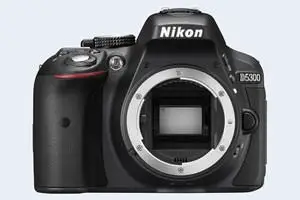Fujifilm XF10 vs Nikon D5300
The Fujifilm XF10 and the Nikon D5300 are two digital cameras that were announced, respectively, in July 2018 and October 2013. The XF10 is a fixed lens compact, while the D5300 is a DSLR. Both cameras are equipped with an APS-C sensor. Both cameras offer a resolution of 24 megapixels.
Below is an overview of the main specs of the two cameras as a starting point for the comparison.

Check XF10 offers at
ebay.com

Check D5300 offers at
ebay.com
Going beyond this snapshot of core features and characteristics, what are the differences between the Fujifilm XF10 and the Nikon D5300? Which one should you buy? Read on to find out how these two cameras compare with respect to their body size, their imaging sensors, their shooting features, their input-output connections, and their reception by expert reviewers.
Body comparison
The physical size and weight of the Fujifilm XF10 and the Nikon D5300 are illustrated in the side-by-side display below. The two cameras are presented according to their relative size. Three consecutive perspectives from the front, the top, and the back are available. All width, height and depth measures are rounded to the nearest millimeter.
The XF10 can be obtained in two different colors (black, gold), while the D5300 is available in three color-versions (black, grey, red).
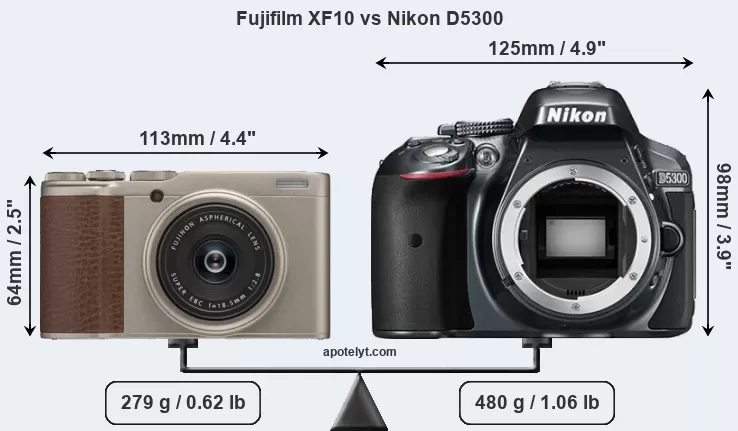
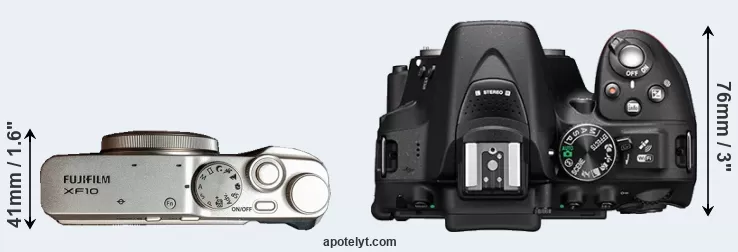
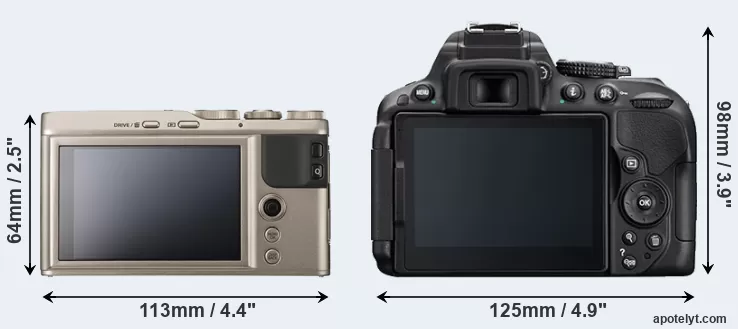
If the front view area (width x height) of the cameras is taken as an aggregate measure of their size, the Nikon D5300 is considerably larger (69 percent) than the Fujifilm XF10. In this context, it is worth noting that neither the XF10 nor the D5300 are weather-sealed.
The above size and weight comparisons are to some extent incomplete and possibly misleading, as the XF10 has a lens built in, whereas the D5300 is an interchangeable lens camera that requires a separate lens. Attaching the latter will add extra weight and bulk to the setup. You can compare the optics available for the D5300 and their specifications in the Nikon Lens Catalog.
Concerning battery life, the XF10 gets 330 shots out of its Fujifilm NP-95 battery, while the D5300 can take 600 images on a single charge of its Nikon EN-EL14a power pack. The power pack in the XF10 can be charged via the USB port, so that it is not always necessary to take the battery charger along when travelling.
The table below summarizes the key physical specs of the two cameras alongside a broader set of comparators. If you would like to visualize and compare a different camera combination, you can navigate to the CAM-parator app and make your selection from a broad list of cameras there.

| Camera Model |
Camera Width |
Camera Height |
Camera Depth |
Camera Weight |
Battery Life |
Weather Sealing |
Camera Launch |
Launch Price (USD) |
Street Price |
||
|---|---|---|---|---|---|---|---|---|---|---|---|
| 1. | Fujifilm XF10 | 113 mm | 64 mm | 41 mm | 279 g | 330 | n | Jul 2018 | 499 | ebay.com | |
| 2. | Nikon D5300 | 125 mm | 98 mm | 76 mm | 480 g | 600 | n | Oct 2013 | 799 | ebay.com | |
| 3. | Canon G9 X Mark II | 98 mm | 58 mm | 31 mm | 206 g | 235 | n | Jan 2017 | 529 | ebay.com | |
| 4. | Canon M100 | 108 mm | 67 mm | 35 mm | 302 g | 295 | n | Aug 2017 | 499 | ebay.com | |
| 5. | Canon SX730 | 110 mm | 64 mm | 40 mm | 300 g | 250 | n | Apr 2017 | 399 | ebay.com | |
| 6. | Fujifilm X-A7 | 119 mm | 68 mm | 41 mm | 320 g | 440 | n | Sep 2019 | 499 | ebay.com | |
| 7. | Fujifilm X-E3 | 121 mm | 74 mm | 43 mm | 337 g | 350 | n | Sep 2017 | 899 | ebay.com | |
| 8. | Fujifilm X-T100 | 121 mm | 83 mm | 47 mm | 448 g | 430 | n | May 2018 | 599 | ebay.com | |
| 9. | Fujifilm X70 | 113 mm | 64 mm | 44 mm | 340 g | 330 | n | Jan 2016 | 799 | ebay.com | |
| 10. | Fujifilm X100F | 127 mm | 75 mm | 52 mm | 469 g | 390 | n | Jan 2017 | 1,299 | ebay.com | |
| 11. | Nikon D3200 | 125 mm | 96 mm | 77 mm | 505 g | 540 | n | Apr 2012 | 599 | ebay.com | |
| 12. | Nikon D3300 | 124 mm | 98 mm | 76 mm | 430 g | 700 | n | Jan 2014 | 499 | ebay.com | |
| 13. | Nikon D5200 | 129 mm | 98 mm | 78 mm | 555 g | 500 | n | Nov 2012 | 749 | ebay.com | |
| 14. | Nikon D5500 | 124 mm | 97 mm | 70 mm | 470 g | 820 | n | Jan 2015 | 899 | ebay.com | |
| 15. | Nikon D5600 | 124 mm | 97 mm | 70 mm | 465 g | 970 | n | Nov 2016 | 699 | ebay.com | |
| 16. | Panasonic ZS70 | 112 mm | 67 mm | 41 mm | 322 g | 380 | n | Apr 2017 | 449 | ebay.com | |
| 17. | Panasonic ZS80 | 112 mm | 69 mm | 42 mm | 327 g | 380 | n | Feb 2019 | 449 | ebay.com | |
| Note: Measurements and pricing do not include easily detachable parts, such as add-on or interchangeable lenses or optional viewfinders. | |||||||||||
Any camera decision will obviously take relative prices into account. The retail prices at the time of the camera’s release place the model in the market relative to other models in the producer’s line-up and the competition. The XF10 was launched at a lower price than the D5300, despite having a lens built in. Usually, retail prices stay at first close to the launch price, but after several months, discounts become available. Later in the product cycle and, in particular, when the replacement model is about to appear, further discounting and stock clearance sales often push the camera price considerably down. Then, after the new model is out, very good deals can frequently be found on the pre-owned market.
Sensor comparison
The size of the imaging sensor is a crucial determinant of image quality. A large sensor will tend to have larger individual pixels that provide better low-light sensitivity, wider dynamic range, and richer color-depth than smaller pixel-units in a sensor of the same technological generation. Moreover, a large sensor camera will give the photographer more control over depth-of-field in the image and, thus, the ability to better isolate a subject from the background. On the downside, larger sensors tend to be more expensive and lead to bigger and heavier cameras and lenses.
Both cameras under consideration feature an APS-C sensor, but their sensors differ slightly in size. The sensor area in the D5300 is 1 percent smaller. They nevertheless have the same format factor of 1.5. Both cameras have a native aspect ratio (sensor width to sensor height) of 3:2.
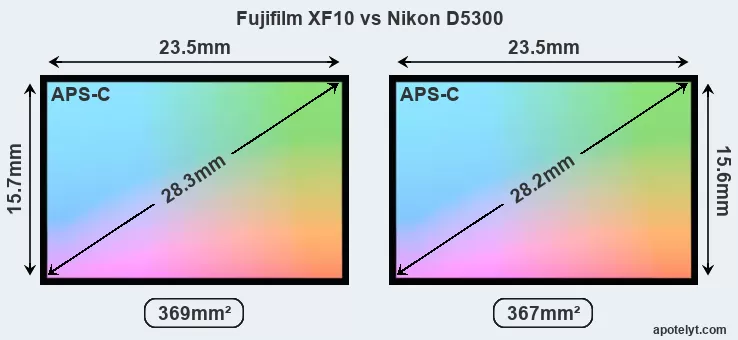
Even though the XF10 has a slightly larger sensor, both cameras offer the same resolution of 24 megapixels. This implies that the XF10 has a lower pixel density and larger individual pixels (with a pixel pitch of 3.92μm versus 3.91μm for the D5300), which gives it a potential advantage in terms of light gathering capacity. In addition, the XF10 is much more recent (by 4 years and 9 months) than the D5300, and its sensor will have benefitted from technological advances during this time. Coming back to sensor resolution, it should be mentioned that the D5300 has no anti-alias filter installed, so that it can capture all the detail its sensor resolves.
The XF10 has on-sensor phase detect pixels, which results in fast and reliable autofocus acquisition even during live view operation.
The Fujifilm XF10 has a native sensitivity range from ISO 200 to ISO 12800, which can be extended to ISO 100-51200. The corresponding ISO settings for the Nikon D5300 are ISO 100 to ISO 12800, with the possibility to increase the ISO range to 100-25600.
Technology-wise, both cameras are equipped with CMOS (Complementary Metal–Oxide–Semiconductor) sensors. Both cameras use a Bayer filter for capturing RGB colors on a square grid of photosensors. This arrangement is found in most digital cameras.
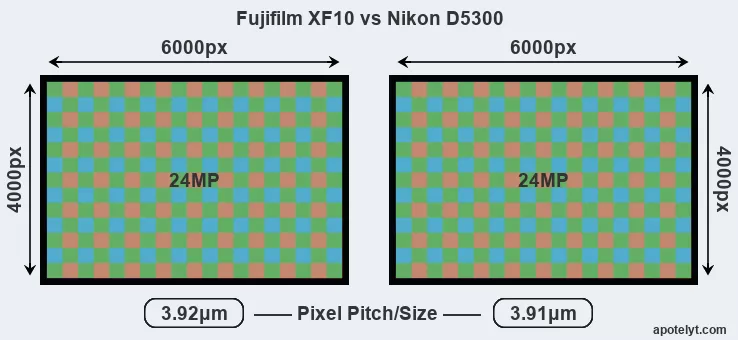
For many cameras, data on sensor performance has been reported by DXO Mark. This service is based on lab testing and assigns an overall score to each camera sensor, as well as ratings for dynamic range ("DXO Landscape"), color depth ("DXO Portrait"), and low-light sensitivity ("DXO Sports"). The table below summarizes the physical sensor characteristics and sensor quality findings and compares them across a set of similar cameras.

| Camera Model |
Sensor Class |
Resolution (MP) |
Horiz. Pixels |
Vert. Pixels |
Video Format |
DXO Portrait |
DXO Landscape |
DXO Sports |
DXO Overall |
||
|---|---|---|---|---|---|---|---|---|---|---|---|
| 1. | Fujifilm XF10 | APS-C | 24.0 | 6000 | 4000 | 4K/15p | 24.0 | 13.4 | 1844 | 83 | |
| 2. | Nikon D5300 | APS-C | 24.0 | 6000 | 4000 | 1080/60p | 24.0 | 13.9 | 1338 | 83 | |
| 3. | Canon G9 X Mark II | 1-inch | 20.0 | 5472 | 3648 | 1080/60p | 21.9 | 12.5 | 522 | 65 | |
| 4. | Canon M100 | APS-C | 24.0 | 6000 | 4000 | 1080/60p | 23.5 | 12.9 | 1272 | 78 | |
| 5. | Canon SX730 | 1/2.3 | 20.2 | 5184 | 3888 | 1080/60p | 20.5 | 11.9 | 924 | 50 | |
| 6. | Fujifilm X-A7 | APS-C | 24.0 | 6000 | 4000 | 4K/30p | 24.1 | 13.6 | 1955 | 84 | |
| 7. | Fujifilm X-E3 | APS-C | 24.0 | 6000 | 4000 | 4K/30p | 23.9 | 13.3 | 1764 | 82 | |
| 8. | Fujifilm X-T100 | APS-C | 24.0 | 6000 | 4000 | 4K/15p | 24.0 | 13.4 | 1829 | 83 | |
| 9. | Fujifilm X70 | APS-C | 16.0 | 4896 | 3264 | 1080/60p | 23.7 | 13.0 | 1608 | 80 | |
| 10. | Fujifilm X100F | APS-C | 24.0 | 6000 | 4000 | 1080/60p | 23.9 | 13.2 | 1704 | 81 | |
| 11. | Nikon D3200 | APS-C | 24.1 | 6016 | 4000 | 1080/30p | 24.1 | 13.2 | 1131 | 81 | |
| 12. | Nikon D3300 | APS-C | 24.0 | 6000 | 4000 | 1080/60p | 24.3 | 12.8 | 1385 | 82 | |
| 13. | Nikon D5200 | APS-C | 24.0 | 6000 | 4000 | 1080/60i | 24.2 | 13.9 | 1284 | 84 | |
| 14. | Nikon D5500 | APS-C | 24.0 | 6000 | 4000 | 1080/60p | 24.1 | 14.0 | 1438 | 84 | |
| 15. | Nikon D5600 | APS-C | 24.0 | 6000 | 4000 | 1080/60p | 24.1 | 14.0 | 1306 | 84 | |
| 16. | Panasonic ZS70 | 1/2.3 | 20.2 | 5184 | 3888 | 4K/30p | 19.1 | 10.6 | 106 | 36 | |
| 17. | Panasonic ZS80 | 1/2.3 | 20.2 | 5184 | 3888 | 4K/30p | 20.7 | 12.2 | 1103 | 52 | |
| Note: DXO values in italics represent estimates based on sensor size and age. | |||||||||||
Many modern cameras are not only capable of taking still images, but can also record movies. The two cameras under consideration both have sensors whose read-out speed is fast enough to capture moving pictures, but the XF10 provides a higher video resolution than the D5300. It can shoot video footage at 4K/15p, while the Nikon is limited to 1080/60p.
Feature comparison
Apart from body and sensor, cameras can and do differ across a variety of features. For example, the D5300 has an optical viewfinder, which can be very useful when shooting in bright sunlight. In contrast, the XF10 relies on live view and the rear LCD for framing. The table below summarizes some of the other core capabilities of the Fujifilm XF10 and Nikon D5300 in connection with corresponding information for a sample of similar cameras.

| Camera Model |
Viewfinder (Type or 000 dots) |
Control Panel (yes/no) |
LCD Specifications (inch/000 dots) |
LCD Attach- ment |
Touch Screen (yes/no) |
Max Shutter Speed * |
Max Shutter Flaps * |
Built-in Flash (yes/no) |
Built-in Image Stab |
||
|---|---|---|---|---|---|---|---|---|---|---|---|
| 1. | Fujifilm XF10 | none | n | 3.0 / 1040 | fixed | Y | 1/4000s | 6.0/s | Y | n | |
| 2. | Nikon D5300 | optical | n | 3.2 / 1037 | swivel | n | 1/4000s | 5.0/s | Y | n | |
| 3. | Canon G9 X Mark II | none | n | 3.0 / 1040 | fixed | Y | 1/2000s | 8.2/s | Y | Y | |
| 4. | Canon M100 | none | n | 3.0 / 1040 | tilting | Y | 1/4000s | 6.1/s | Y | n | |
| 5. | Canon SX730 | none | n | 3.0 / 922 | tilting | n | 1/3200s | 5.9/s | Y | Y | |
| 6. | Fujifilm X-A7 | none | n | 3.5 / 2760 | swivel | Y | 1/4000s | 6.0/s | Y | n | |
| 7. | Fujifilm X-E3 | 2360 | n | 3.0 / 1040 | fixed | Y | 1/4000s | 8.0/s | n | n | |
| 8. | Fujifilm X-T100 | 2360 | n | 3.0 / 1040 | swivel | Y | 1/4000s | 6.0/s | Y | n | |
| 9. | Fujifilm X70 | optional | n | 3.0 / 1040 | tilting | Y | 1/4000s | 8.0/s | Y | n | |
| 10. | Fujifilm X100F | 2360 | n | 3.0 / 1040 | fixed | n | 1/4000s | 8.0/s | Y | n | |
| 11. | Nikon D3200 | optical | n | 3.0 / 921 | fixed | n | 1/4000s | 4.0/s | Y | n | |
| 12. | Nikon D3300 | optical | n | 3.0 / 921 | fixed | n | 1/4000s | 5.0/s | Y | n | |
| 13. | Nikon D5200 | optical | n | 3.0 / 921 | swivel | n | 1/4000s | 5.0/s | Y | n | |
| 14. | Nikon D5500 | optical | n | 3.2 / 1037 | swivel | Y | 1/4000s | 5.0/s | Y | n | |
| 15. | Nikon D5600 | optical | n | 3.2 / 1037 | swivel | Y | 1/4000s | 5.0/s | Y | n | |
| 16. | Panasonic ZS70 | 1166 | n | 3.0 / 1040 | tilting | Y | 1/2000s | 10.0/s | Y | Y | |
| 17. | Panasonic ZS80 | 2330 | n | 3.0 / 1040 | tilting | Y | 1/2000s | 10.0/s | Y | Y | |
| Note: *) Information refers to the mechanical shutter, unless the camera only has an electronic one. | |||||||||||
One differentiating feature between the two cameras concerns the touch sensitivity of the rear screen. The XF10 has a touchscreen, while the D5300 has a conventional panel. Touch control can be particularly helpful, for example, for setting the focus point.
The D5300 has an articulated screen that can be turned to be front-facing. This characteristic will be appreciated by vloggers and photographers who are interested in taking selfies. In contrast, the XF10 does not have a selfie-screen.The reported shutter speed information refers to the use of the mechanical shutter. Yet, some cameras only have an electronic shutter, while others have an electronic shutter in addition to a mechanical one. In fact, the XF10 is one of those camera that have an additional electronic shutter, which makes completely silent shooting possible. However, this mode is less suitable for photographing moving objects (risk of rolling shutter) or shooting under artificial light sources (risk of flickering).
The Fujifilm XF10 and the Nikon D5300 both have an intervalometer built-in. This enables the photographer to capture time lapse sequences, such as flower blooming, a sunset or moon rise, without purchasing an external camera trigger and related software.
Concerning the storage of imaging data, both the XF10 and the D5300 write their files to SDXC cards. Both cameras can use UHS-I cards, which provide for Ultra High Speed data transfer of up to 104 MB/s.
Connectivity comparison
For some imaging applications, the extent to which a camera can communicate with its environment can be an important aspect in the camera decision process. The table below provides an overview of the connectivity of the Fujifilm XF10 and Nikon D5300 and, in particular, the interfaces the cameras (and selected comparators) provide for accessory control and data transfer.

| Camera Model |
Hotshoe Port |
Internal Mic / Speaker |
Microphone Port |
Headphone Port |
HDMI Port |
USB Port |
WiFi Support |
NFC Support |
Bluetooth Support |
||
|---|---|---|---|---|---|---|---|---|---|---|---|
| 1. | Fujifilm XF10 | - | stereo / mono | Y | - | micro | 2.0 | Y | - | Y | |
| 2. | Nikon D5300 | Y | stereo / mono | Y | - | mini | 2.0 | Y | - | - | |
| 3. | Canon G9 X Mark II | - | stereo / mono | - | - | micro | 2.0 | Y | Y | Y | |
| 4. | Canon M100 | - | stereo / mono | - | - | micro | 2.0 | Y | Y | Y | |
| 5. | Canon SX730 | - | stereo / mono | - | - | micro | 2.0 | Y | Y | Y | |
| 6. | Fujifilm X-A7 | Y | stereo / mono | Y | - | micro | 2.0 | Y | - | Y | |
| 7. | Fujifilm X-E3 | Y | stereo / mono | Y | - | micro | 2.0 | Y | - | Y | |
| 8. | Fujifilm X-T100 | Y | stereo / mono | Y | - | micro | 2.0 | Y | - | Y | |
| 9. | Fujifilm X70 | Y | stereo / mono | Y | - | micro | 2.0 | Y | - | - | |
| 10. | Fujifilm X100F | Y | stereo / mono | Y | - | micro | 2.0 | Y | - | - | |
| 11. | Nikon D3200 | Y | mono / mono | Y | - | mini | 2.0 | - | - | - | |
| 12. | Nikon D3300 | Y | mono / mono | Y | - | mini | 2.0 | - | - | - | |
| 13. | Nikon D5200 | Y | stereo / mono | Y | - | mini | 2.0 | - | - | - | |
| 14. | Nikon D5500 | Y | stereo / mono | Y | - | mini | 2.0 | Y | - | - | |
| 15. | Nikon D5600 | Y | stereo / mono | Y | - | mini | 2.0 | Y | Y | Y | |
| 16. | Panasonic ZS70 | - | stereo / mono | - | - | micro | 2.0 | Y | - | - | |
| 17. | Panasonic ZS80 | - | stereo / mono | - | - | micro | 2.0 | Y | - | Y |
It is notable that the D5300 has a hotshoe, which makes it possible to easily attach optional accessories, such as an external flash gun. The XF10 does not feature such an accessory-socket.
Travel and landscape photographers will find it useful that the D5300 has an internal geolocalization sensor and can record GPS coordinates in its EXIF data.
Both the XF10 and the D5300 have been discontinued, but can regularly be found used on ebay. The D5300 was replaced by the Nikon D5500, while the XF10 does not have a direct successor. Further information on the features and operation of the XF10 and D5300 can be found, respectively, in the Fujifilm XF10 Manual (free pdf) or the online Nikon D5300 Manual.
Review summary
So what is the bottom line? Which of the two cameras – the Fujifilm XF10 or the Nikon D5300 – has the upper hand? Is one clearly better than the other? A synthesis of the relative strong points of each of the models is listed below.

Arguments in favor of the Fujifilm XF10:
- Better moiré control: Has an anti-alias filter to avoid artificial patterns to appear in images.
- Better video: Provides higher definition movie capture (4K/15p vs 1080/60p).
- Better live-view autofocus: Features on-sensor phase-detection for more confident autofocus.
- Fewer buttons to press: Is equipped with a touch-sensitive rear screen to facilitate handling.
- Faster burst: Shoots at higher frequency (6 vs 5 flaps/sec) to capture the decisive moment.
- Less disturbing: Has an electronic shutter option for completely silent shooting.
- Ready to shoot: Comes with a built-in lens, while the D5300 requires a separate lens.
- More compact: Is smaller (113x64mm vs 125x98mm) and thus needs less room in the bag.
- Less heavy: Is lighter even though it comes with a built-in lens (unlike the D5300).
- Easier travel charging: Can be conveniently charged via its USB port.
- Easier wireless transfer: Supports Bluetooth for image sharing without cables.
- More affordable: Was introduced at a lower price, despite coming with a built-in lens.
- More modern: Reflects 4 years and 9 months of technical progress since the D5300 launch.

Advantages of the Nikon D5300:
- Maximized detail: Lacks an anti-alias filter to exploit the sensor's full resolution potential.
- Easier framing: Has an optical viewfinder for image composition and settings control.
- Larger screen: Has a bigger rear LCD (3.2" vs 3.0") for image review and settings control.
- More flexible LCD: Has a swivel screen for odd-angle shots in portrait or landscape orientation.
- More selfie-friendly: Has an articulated screen that can be turned to be front-facing.
- More flexible: Makes it possible to change lenses and thus to use specialty optics.
- Longer lasting: Gets more shots (600 versus 330) out of a single battery charge.
- Better lighting: Features a hotshoe and can thus hold and trigger an external flash gun.
- Easier geotagging: Features an internal GPS sensor to log localization data.
- More heavily discounted: Has been around for much longer (launched in October 2013).
If the count of relative strengths (bullet points above) is taken as a measure, the XF10 emerges as the winner of the contest (13 : 10 points). However, the relative importance of the various individual camera aspects will vary according to personal preferences and needs, so that you might like to apply corresponding weights to the particular features before making a decision on a new camera. A professional wildlife photographer will view the differences between cameras in a way that diverges from the perspective of a family photog, and a person interested in architecture has distinct needs from a sports shooter. Hence, the decision which camera is best and worth buying is often a very personal one.
How about other alternatives? Do the specifications of the Fujifilm XF10 and the Nikon D5300 place the cameras among the top in their class? Find out in the latest Best Prime Lens Compact Camera and Best DSLR Camera listings whether the two cameras rank among the cream of the crop.
In any case, while the comparison of technical specifications can provide a useful overview of the capabilities of different cameras, it remains incomplete and does no justice, for example, to the way the XF10 or the D5300 perform in practice. User reviews that are available, for instance, at amazon can sometimes shed light on these issues, but such feedback is all too often partial, inconsistent, and inaccurate.
Expert reviews
This is where reviews by experts come in. The adjacent summary-table relays the overall verdicts of several of the most popular camera review sites (amateurphotographer [AP], cameralabs [CL], digitalcameraworld [DCW], dpreview [DPR], ephotozine [EPZ], photographyblog [PB]). As can be seen, the professional reviewers agree in many cases on the quality of different cameras, but sometimes their assessments diverge, reinforcing the earlier point that a camera decision is often a very personal choice.

| Camera Model |
AP score |
CL score |
DCW score |
DPR score |
EPZ score |
PB score |
Camera Launch |
Launch Price (USD) |
Street Price |
||
|---|---|---|---|---|---|---|---|---|---|---|---|
| 1. | Fujifilm XF10 | .. | .. | 4/5 | 75/100 | 4/5 | 4.5/5 | Jul 2018 | 499 | ebay.com | |
| 2. | Nikon D5300 | 4/5 | + + | .. | 79/100 | 4.5/5 | 4.5/5 | Oct 2013 | 799 | ebay.com | |
| 3. | Canon G9 X Mark II | 4/5 | .. | 4/5 | 75/100 | 4.5/5 | 4.5/5 | Jan 2017 | 529 | ebay.com | |
| 4. | Canon M100 | 3/5 | + | .. | .. | 4/5 | 3.5/5 | Aug 2017 | 499 | ebay.com | |
| 5. | Canon SX730 | .. | + | .. | .. | 4/5 | 4/5 | Apr 2017 | 399 | ebay.com | |
| 6. | Fujifilm X-A7 | 3/5 | .. | 3.5/5 | 81/100 | 4/5 | 3.5/5 | Sep 2019 | 499 | ebay.com | |
| 7. | Fujifilm X-E3 | 4.5/5 | + | 4.5/5 | 84/100 | 4.5/5 | 4.5/5 | Sep 2017 | 899 | ebay.com | |
| 8. | Fujifilm X-T100 | 4/5 | + | 4.5/5 | 79/100 | 4/5 | 4.5/5 | May 2018 | 599 | ebay.com | |
| 9. | Fujifilm X70 | 4.5/5 | .. | .. | 76/100 | 4.5/5 | 4.5/5 | Jan 2016 | 799 | ebay.com | |
| 10. | Fujifilm X100F | 5/5 | + | 3.9/5 | 83/100 | 4.5/5 | 4.5/5 | Jan 2017 | 1,299 | ebay.com | |
| 11. | Nikon D3200 | 5/5 | + + | .. | 73/100 | 4.5/5 | 4.5/5 | Apr 2012 | 599 | ebay.com | |
| 12. | Nikon D3300 | 3/5 | + | .. | 77/100 | 4.5/5 | 4.5/5 | Jan 2014 | 499 | ebay.com | |
| 13. | Nikon D5200 | 4/5 | + + | .. | 79/100 | 4.5/5 | 4.5/5 | Nov 2012 | 749 | ebay.com | |
| 14. | Nikon D5500 | 5/5 | + | .. | 79/100 | 4.5/5 | 4.5/5 | Jan 2015 | 899 | ebay.com | |
| 15. | Nikon D5600 | 4/5 | .. | 4/5 | 79/100 | 4.5/5 | 4/5 | Nov 2016 | 699 | ebay.com | |
| 16. | Panasonic ZS70 | .. | + + | .. | .. | 4/5 | 4/5 | Apr 2017 | 449 | ebay.com | |
| 17. | Panasonic ZS80 | .. | + + | .. | .. | 4.5/5 | .. | Feb 2019 | 449 | ebay.com | |
| Note: (+ +) highly recommended; (+) recommended; (o) reviewed; (..) not available. | |||||||||||
The review scores listed above should be treated with care, though. The ratings are only valid when referring to cameras in the same category and of the same age. A score, therefore, has to be seen in close connection to the price and market introduction time of the camera, and rating-comparisons among cameras that span long time periods or concern very differently equipped models make little sense. Also, please note that some of the review sites have changed their methodology and reporting over time.

Check XF10 offers at
ebay.com

Check D5300 offers at
ebay.com
Other camera comparisons
Did this review help to inform your camera decision process? In case you are interested in seeing how other cameras pair up, just make your choice using the following search menu. Alternatively, you can follow any of the listed hyperlinks for comparisons that others found interesting.
- Canon 600D vs Nikon D5300
- Canon 760D vs Fujifilm XF10
- Canon RP vs Fujifilm XF10
- Fujifilm X-H2S vs Nikon D5300
- Fujifilm XF10 vs Leica X Vario
- Fujifilm XF10 vs Nikon D5000
- Fujifilm XF10 vs Olympus E-500
- Fujifilm XF10 vs Sony NEX-5
- Nikon D2H vs Nikon D5300
- Nikon D5300 vs Nikon D780
- Nikon D5300 vs Panasonic GF7
- Nikon D5300 vs Sony ZV-1F
Specifications: Fujifilm XF10 vs Nikon D5300
Below is a side-by-side comparison of the specs of the two cameras to facilitate a quick review of their differences and common features.
| Camera Model | Fujifilm XF10 | Nikon D5300 |
|---|---|---|
| Camera Type | Fixed lens compact camera | Digital single lens reflex |
| Camera Lens | 28mm f/2.8-16 | Nikon F mount lenses |
| Launch Date | July 2018 | October 2013 |
| Launch Price | USD 499 | USD 799 |
| Sensor Specs | Fujifilm XF10 | Nikon D5300 |
| Sensor Technology | CMOS | CMOS |
| Sensor Format | APS-C Sensor | APS-C Sensor |
| Sensor Size | 23.5 x 15.7 mm | 23.5 x 15.6 mm |
| Sensor Area | 368.95 mm2 | 366.6 mm2 |
| Sensor Diagonal | 28.3 mm | 28.2 mm |
| Crop Factor | 1.5x | 1.5x |
| Sensor Resolution | 24 Megapixels | 24 Megapixels |
| Image Resolution | 6000 x 4000 pixels | 6000 x 4000 pixels |
| Pixel Pitch | 3.92 μm | 3.91 μm |
| Pixel Density | 6.50 MP/cm2 | 6.55 MP/cm2 |
| Moiré control | Anti-Alias filter | no AA filter |
| Movie Capability | 4K/15p Video | 1080/60p Video |
| ISO Setting | 200 - 12,800 ISO | 100 - 12,800 ISO |
| ISO Boost | 100 - 51,200 ISO | 100 - 25,600 ISO |
| DXO Sensor Quality (score) | .. | 83 |
| DXO Color Depth (bits) | .. | 24.0 |
| DXO Dynamic Range (EV) | .. | 13.9 |
| DXO Low Light (ISO) | .. | 1338 |
| Screen Specs | Fujifilm XF10 | Nikon D5300 |
| Viewfinder Type | no viewfinder | Optical viewfinder |
| Viewfinder Field of View | 95% | |
| Viewfinder Magnification | 0.57x | |
| LCD Framing | Live View | Live View |
| Rear LCD Size | 3.0inch | 3.2inch |
| LCD Resolution | 1040k dots | 1037k dots |
| LCD Attachment | Fixed screen | Swivel screen |
| Touch Input | Touchscreen | no Touchscreen |
| Shooting Specs | Fujifilm XF10 | Nikon D5300 |
| Focus System | On-Sensor Phase-detect | Phase-detect AF |
| Manual Focusing Aid | Focus Peaking | no Peaking Feature |
| Continuous Shooting | 6 shutter flaps/s | 5 shutter flaps/s |
| Electronic Shutter | up to 1/16000s | no E-Shutter |
| Time-Lapse Photography | Intervalometer built-in | Intervalometer built-in |
| Fill Flash | Built-in Flash | Built-in Flash |
| Storage Medium | SDXC cards | SDXC cards |
| Single or Dual Card Slots | Single card slot | Single card slot |
| UHS card support | UHS-I | UHS-I |
| Connectivity Specs | Fujifilm XF10 | Nikon D5300 |
| External Flash | no Hotshoe | Hotshoe |
| USB Connector | USB 2.0 | USB 2.0 |
| HDMI Port | micro HDMI | mini HDMI |
| Microphone Port | External MIC port | External MIC port |
| Wifi Support | Wifi built-in | Wifi built-in |
| Bluetooth Support | Bluetooth built-in | no Bluetooth |
| Geotagging | no internal GPS | GPS built-in |
| Body Specs | Fujifilm XF10 | Nikon D5300 |
| Battery Type | Fujifilm NP-95 | Nikon EN-EL14a |
| Battery Life (CIPA) | 330 shots per charge | 600 shots per charge |
| In-Camera Charging | USB charging | no USB charging |
| Body Dimensions |
113 x 64 x 41 mm (4.4 x 2.5 x 1.6 in) |
125 x 98 x 76 mm (4.9 x 3.9 x 3.0 in) |
| Camera Weight | 279 g (9.8 oz) | 480 g (16.9 oz) |

Check XF10 offers at
ebay.com

Check D5300 offers at
ebay.com
Did you notice an error on this page? If so, please get in touch, so that we can correct the information.

